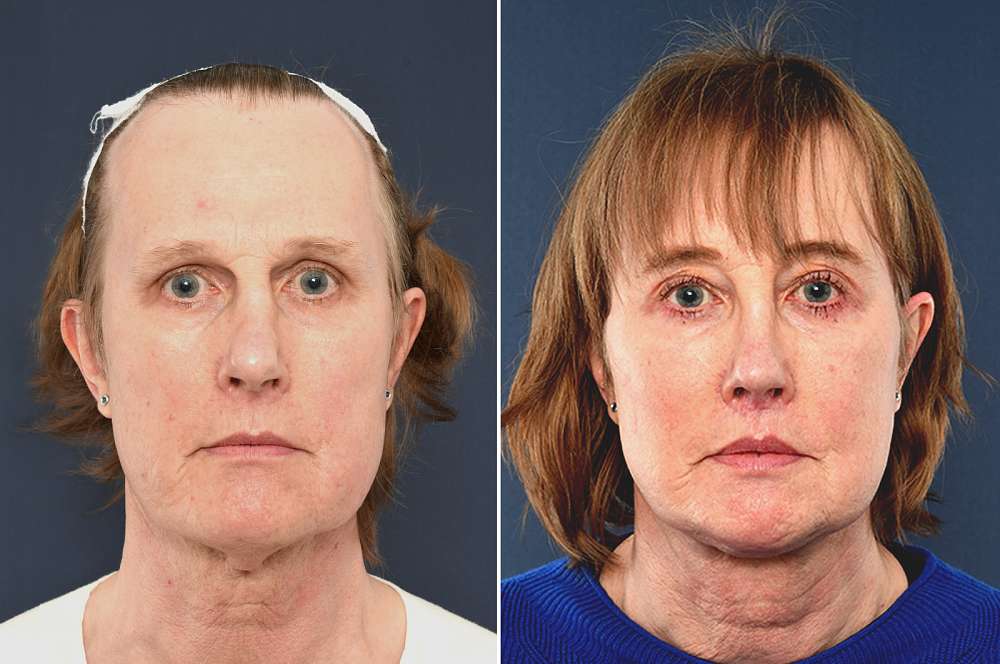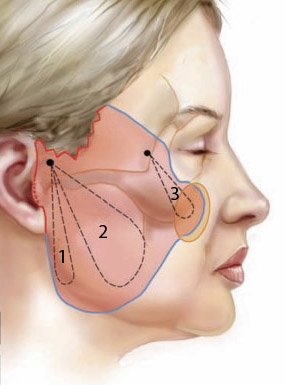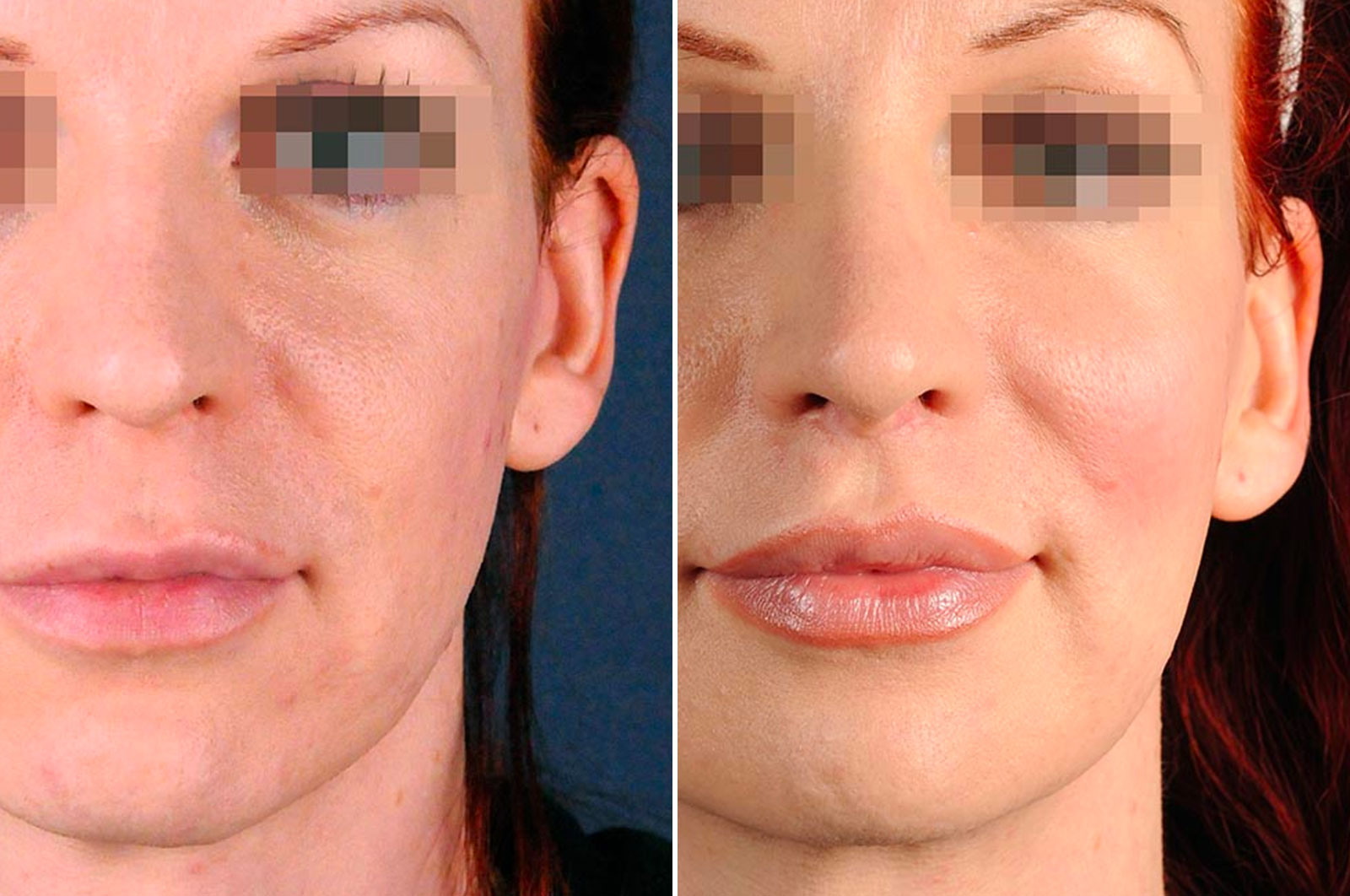Facelift surgery
Table of contents:
Dr Bart van de Ven performs three types of facelift that each have their indication: a simple facelift, a necklift and a midfacelift. If no jaw reduction or chin recontouring is performed, it can be done at the same time as the rest of your Facial Feminization Surgery.
















Indications
1 Indication simple facelift
- Existing sagging skin (jowls)
- After a jaw and chin recontouring in older patients—After a jaw and chin recontouring in older patients, a not previously existing sagging of skin may appear. This is because the volume of the jaw and chin has been reduced, and the swelling after this type of surgery can be massive. In a young patient with good and elastic skin, the skin recuperates from all that stretching. If you are older, the skin will not completely readapt to the new jaw shape. That is why a lot of older FFS patients (late 30’s and older) may need a facelift. A facelift is best not performed at the same time as a jaw and chin recontouring because the result is suboptimal. We recommend at least 4 months between the two operations. The facelift helps enormously to show off the newly formed jaw and chin, resulting in a very female shape of the face.
- Can be combined with a neck lift and mid-facelift if needed (see indications below).
2 Indication neck lift
- Excess skin in the neck
- Almost always performed in combination with a facelift
3 Indication mid-facelift
- Drooping corners of the mouth.
- After a substantial lip lift—It is often indicated when getting a substantial lip lift. A lip lift doesn’t lift the corners of the mouth, and without a mid-facelift, the mouth of the patient can become a bit sad-looking.
- Younger patients who don’t need a complete facelift yet—It also can be very helpful in patients under 40 years of age who don’t need a complete facelift yet. A subperiosteal mid-facelift ist a very effective way of lifting the cheeks and the corners of the mouth. As a side effect, it will also lift the jowls a bit.
How to prepare for a facelift?
If you are a smoker, you should stop smoking three weeks prior to the surgery and wait with taking it up again until three weeks after. Smoking seriously reduces the blood supply of the skin and may lead to serious wound healing problems.
Procedures
1 Procedure simple facelift
For a facelift, Dr Bart van de Ven uses the MACS-lift technique, a technique developed by Dr Patrick Tonnard and Dr Alexis Verpaele. A MACS-lift stands for Minimal Access Cranial Suspension lift. ‘Minimal Access’ means a short incision, so a short scar. As the skin and underlying layer of the lower part of the face are purely lifted in a vertical direction during this procedure, there is no need for an incision behind the ear. The MACS-lift is a very safe and fast way of facelifting with excellent and long-lasting results.
- General anesthesia.
- Incision—The incision is kept as short a possible and runs in front of the ear.
- Undermining—The skin is undermined (made loose from the layers below it) in the area.
- Three loop sutures—Three sutures are placed to lift the tissues. These sutures absorb after 6 months. This is enough time for the tissues to heal in their new position.
- Excess neck skin removed—The excess of skin is excised and the skin closed.

2 Procedure neck lift
If a patient has too much loose skin in the neck, the incision of the MACS-lift (in front of the ear) needs to be extended behind the ears. Only then the surplus of neck skin can be excised.
- Same procedure as simple facelift.
- Extension Incision—The procedure is comparable to the MACS-lift, but the incision is extended behind the ears and in the hair about 2mm behind the hairline.
- Extension Undermining—The skin of the neck is undermined (made loose from the layers below it) in the area.
- Extra loop suture—A suture is anchored to the strong bone membrane (periosteum) just behind the ear and runs into the neck and back, so the platysma muscle can be tightened.
- Excess neck skin removed—The excess of skin is excised and the skin closed.
3 Procedure mid-facelift
- Incision under the eyes—Incisions are made just under the eyelashes of the lower lids and continued until about 1,5cm lateral to the corners of the eyes.
- Mobilization—The cheeks will be mobilized by a preparation just over the bone (subperiosteal).
- Incision in the mouth—To make the cheeks more mobile the bone membrane is incised on several places through an incision on the inside of the mouth.
- Burring holes—Three small holes are burred into the bone just under the eyes to anchor the sutures.
- Permanent loop sutures—With a special instrument 3 nylon sutures are pulled through the cheeks and tied through the bur holes. This will forcefully lift the cheeks and corners of the mouth.
- Excess skin removed—Finally, the surplus skin of the lower eyelids which is a result of the lifting needs to be excised, and then the wounds are closed.

Recovery
- First week—There will be some bruising and swelling in the neck and at the jawline and some bruising around the eyes.
- Subsequent weeks—After three weeks the patient can resume social activities, if necessary with some make-up around the eyes to cover the remaining bruising.
- Full recovery—After three to four weeks.
Frequently asked questions
What does this procedure cost?
You can find estimated prices here, after your consultation you will be informed of the exact prices of your operation. Prices are average and may vary depending on the exact treatment.
There are 3 options to receive a financial and operative proposal. You can either send us pictures and receive a quote and an FFS simulation, or you can book a Skype or a live consultation with Dr Bart van de Ven during which you will also receive a quote and FFS simulation. Click here if you want to get a general idea of FFS prices.
What happens if there are complications after the procedure and is this covered?
We will correct the complication if surgically possible, without charging any surgical fees. Hospital, material and traveling costs are for the expense of the patient.
Can I lose feeling (numbness) permanently in some areas following FFS surgery?
Some temporary numbness in any of the areas where bone work is done is an absolute certainty. That could include the scalp, forehead, chin, jaw or even cheek areas depending on where the surgery has been done. This happens because the soft tissue is detached from the bony area. Several thousand minor nerves are severed, and it will obviously take some while for those areas to heal. Up to 18 months of recovery time is not unusual, but it usually takes less time. You may not regain the same level of feeling as before.
Can I get this surgery if I’m a cis woman?
Yes, of course. We perform Facial Feminization Surgery on all women. Every woman is welcome at our clinic!
How long does it take for the final result to be visible and the bruises to disappear completely?
Recovery looks different for every patient, but bruising usually disappears after two to four weeks. The final result can be visible after a few months, but it may also take longer than a year. All information on recovering from FFS can be found on our recovery page.
Can a facelift be performed at the same time as a jaw angle reduction?
The swelling after a jaw angle reduction can be massive. That is why a facelift is best not performed at the same time as a jaw recontouring. The results will be suboptimal. We recommend at least 4 months between the two operations. The facelift helps enormously to show off the newly formed jaw and chin, resulting in a very female shape of the face.
How long does it take to completely recover from a facelift?
You should count on not being as socially active as normal for about two to three weeks. The swelling starts to subside on the third day and is usually hardly visible after a week to ten days. You can go out (for shopping, etc.) from the first day after the operation.
What about smoking?
As smoking counteracts wound healing we strongly advise against smoking during the 3 weeks before surgery until 3 weeks after surgery. Smoking dramatically increases the risk of skin necrosis and should be avoided at all times.
We are doing our very best to keep this information up-to-date. In case you see anything that no longer seems accurate, or in case you have a question, please fill out the form below!
